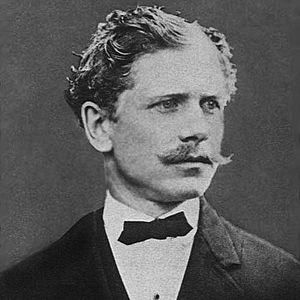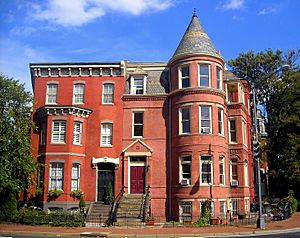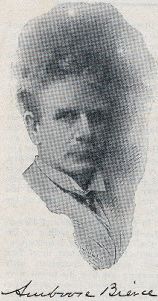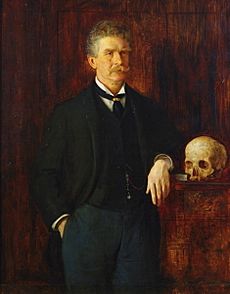Ambrose Bierce facts for kids
Quick facts for kids
Ambrose Bierce
|
|
|---|---|

Bierce around 1866
|
|
| Born | Ambrose Gwinnett Bierce June 24, 1842 Meigs County, Ohio, United States |
| Died | Disappeared c. 1914 (aged 71–72) ; Unknown |
| Occupation | Soldier · Journalist · Writer |
| Genres | Satire, journalism, short story, horror fiction, war fiction, fantasy, science fiction, western, memoir, humor, literary criticism, poetry |
| Literary movement | Realism |
| Notable works | "Chickamauga" "An Occurrence at Owl Creek Bridge" "The Death of Halpin Frayser" "The Moonlit Road" The Devil's Dictionary Tales of Soldiers and Civilians |
| Spouse |
Mary Ellen "Mollie" Day
(m. 1871; div. 1904) |
| Children | 3 |
| Signature | |
| Military career | |
| Allegiance | United States of America |
| Service/ |
Union Army |
| Years of service | 1861–1866 |
| Rank | |
| Unit | 9th Indiana Infantry Regiment |
| Battles/wars | American Civil War
|
Ambrose Gwinnett Bierce (June 24, 1842 – c. 1914) was an American writer, journalist, and American Civil War veteran. He was known for his short stories, especially those about war and horror. His book The Devil's Dictionary is a famous collection of funny and satirical definitions.
Bierce was also a very important journalist in the United States. Many people saw him as a pioneer in writing realistic stories. Some experts even compare his horror writing to famous authors like Edgar Allan Poe. His war stories influenced other great writers such as Stephen Crane and Ernest Hemingway. In 1913, Bierce went to Mexico to see the Mexican Revolution for himself. He disappeared there and was never seen again.
Contents
Early Life and Education
Ambrose Bierce was born on June 24, 1842, in a log cabin in Meigs County, Ohio. His parents, Marcus Aurelius Bierce and Laura Sherwood Bierce, were not rich but loved books and writing. They taught Ambrose to love reading and writing too.
He was the tenth of thirteen children. All his brothers and sisters had names starting with the letter "A". Ambrose grew up in Kosciusko County, Indiana, and went to high school in Warsaw, Indiana. When he was 15, he left home to work at a small newspaper called Northern Indianan. This newspaper supported the idea of ending slavery.
Military Career and War Experiences
Before the American Civil War began, Bierce briefly attended the Kentucky Military Institute. When the war started, he joined the Union Army in the 9th Indiana Infantry Regiment. He fought in many important battles.
One of his most intense experiences was the Battle of Shiloh in April 1862. This terrifying event later inspired several of his short stories and a memoir called "What I Saw of Shiloh." In 1863, he became a first lieutenant. He worked as a mapmaker for General William Babcock Hazen, drawing maps of battlefields.
In June 1864, Bierce was badly injured in the head during the Battle of Kennesaw Mountain. He spent the summer recovering and returned to duty in September. He left the army in January 1865. His military service continued in 1866 when he joined General Hazen on a trip to inspect military bases across the Great Plains. This journey ended in San Francisco, California.
Personal Life and Family
Ambrose Bierce married Mary Ellen "Mollie" Day on December 25, 1871. They had three children: two sons, Day and Leigh, and a daughter, Helen. Sadly, both of Bierce's sons died before him. Day died in 1889, and Leigh died from pneumonia in 1901.
Bierce and his wife separated in 1888 and divorced in 1904. Mollie Day Bierce passed away the next year. Bierce had asthma throughout his life. He also suffered from health problems caused by his war wounds, including fainting spells and being easily annoyed, which were linked to his head injury from Kennesaw Mountain.
Journalism and Writing Career
After leaving the army, Bierce stayed in San Francisco. He became a well-known writer and editor for many newspapers and magazines. These included The San Francisco News Letter, The Argonaut, and The Wasp.
From 1872 to 1875, Bierce lived and wrote in England. He wrote for Fun magazine. His first book, The Fiend's Delight, was published in London in 1873. He used the pen name "Dod Grile" for this book.
After returning to the United States, he continued his journalism career in San Francisco. From 1881 to 1885, he was the editor of The Wasp magazine. He also started writing a column called "Prattle." He later became a regular writer for William Randolph Hearst's newspaper, The San Francisco Examiner. He was one of the most important and influential writers on the West Coast for Hearst's newspapers until 1909.
Fighting for Fairness

In 1896, Hearst sent Bierce to Washington, D.C., to stop a bill in Congress. This bill would have allowed the Union Pacific and Central Pacific railroad companies to avoid paying back large loans they owed to the U.S. government. These loans were worth $130 million at the time.
The railroad companies wanted to pass the bill secretly. When one of the railroad executives, Collis P. Huntington, asked Bierce how much money it would take for him to stop writing about it, Bierce's famous reply was: "My price is one hundred thirty million dollars." Bierce's strong articles and public outcry helped defeat the bill.
A Controversial Poem
Bierce was known for his sharp and critical writing. Sometimes, his columns caused big problems for Hearst. One famous example happened after President William McKinley was assassinated. Bierce had written a poem about the assassination of Governor William Goebel in 1900.
The poem seemed to predict McKinley's death:
The bullet that pierced Goebel's breast
Can not be found in all the West;
Good reason, it is speeding here
To stretch McKinley on his bier.
Because of this poem, Hearst was accused by other newspapers of calling for McKinley's assassination. Even though it caused a national uproar, Hearst continued to employ Bierce.
Literary Works and Style
During his life, Ambrose Bierce was more famous as a journalist than as a fiction writer. However, his most popular stories were written quickly between 1888 and 1891. Bierce's stories often show how mysterious the world can be and how strange death is.
He wrote very realistically about the terrible things he saw in the American Civil War. Stories like "An Occurrence at Owl Creek Bridge" and "Chickamauga" are examples. His collection of 25 war stories is considered a powerful anti-war message in American literature.
Bierce also helped create the psychological horror story. He wrote ghost stories and war stories, and also published several books of poetry. His Fantastic Fables were ahead of their time, using an ironic and strange style that became popular later.
One of his most famous works is The Devil's Dictionary. It started as short newspaper pieces and was published as a book in 1906. It's known for its funny and sarcastic definitions of English words, making fun of common sayings and political talk.
Some people criticized Bierce for using "trick endings" in his stories. However, writers like Stephen Crane and H. P. Lovecraft admired his experimental and "grim and savage" style. Critic William Dean Howells even called Bierce "among our three greatest writers."
Mysterious Disappearance
In October 1913, when he was 71 years old, Bierce left Washington, D.C. He planned to visit his old Civil War battlefields. By December, he had traveled through Louisiana and Texas and crossed into Mexico. Mexico was in the middle of the Mexican Revolution at the time.
In Ciudad Juárez, Bierce joined Pancho Villa's army as an observer. He watched the Battle of Tierra Blanca. It was reported that he went with Villa's army as far as the city of Chihuahua. His last known message was a letter he wrote from there to his friend Blanche Partington, dated December 26, 1913. He ended the letter by saying, "As to me, I leave here tomorrow for an unknown destination."
After that, he disappeared without a trace. His disappearance is one of the most famous mysteries in American literary history. Many theories exist, but no one knows for sure what happened to him. In one of his last letters, he wrote: "Good-bye. If you hear of my being stood up against a Mexican stone wall and shot to rags, please know that I think it is a pretty good way to depart this life. It beats old age, disease, or falling down the cellar stairs."
Legacy and Influence

Ambrose Bierce has appeared as a character in more than 50 novels, short stories, movies, TV shows, plays, and comic books. These works often focus on his interesting personality, his friendships with famous people like Jack London, or his mysterious disappearance.
His short stories, "Haita the Shepherd" and "An Inhabitant of Carcosa", influenced early weird-fiction writers like Robert W. Chambers. Chambers, in turn, influenced H. P. Lovecraft and much of modern horror fiction.
In 1918, writer H. L. Mencken called Bierce "the one genuine wit that These States have ever seen."
At least three films have been made from Bierce's story "An Occurrence at Owl Creek Bridge". A French version from 1962, La Rivière du Hibou, was even shown on the American TV series The Twilight Zone. The story has also been adapted for radio shows like Alfred Hitchcock Presents and Suspense.
In 2005, author Kurt Vonnegut called "An Occurrence at Owl Creek Bridge" the "greatest American short story" and a work of "flawless... American genius."
Bierce's disappearance and trip to Mexico are also part of the vampire horror film From Dusk Till Dawn 3: The Hangman's Daughter (2000). He also appears as a character in Winston Groom's 2016 novel El Paso.
Critic S. T. Joshi has praised Bierce for his sharp humor, saying that Bierce's "dark view of humanity" makes him a unique figure in literature.
Works
Ambrose Bierce wrote many different types of works, including stories, fables, and poetry.
Notable Books
- The Fiend's Delight (1873)
- Tales of Soldiers and Civilians (1891) - A collection of his famous war stories.
- Can Such Things Be? (1893) - A collection of his supernatural and horror stories.
- Fantastic Fables (1899)
- The Devil's Dictionary (1906) - Known for its satirical definitions.
- Write It Right: A Little Blacklist of Literary Faults (1909) - A guide on using words precisely.
- The Collected Works of Ambrose Bierce (1909–1912) - A twelve-volume collection of his writings.
Short Stories
Bierce wrote many short stories, including famous war stories and supernatural tales.
|
|
Images for kids
See also
 In Spanish: Ambrose Bierce para niños
In Spanish: Ambrose Bierce para niños
- List of horror fiction authors
- List of people who disappeared
- List of authors in war
- List of American print journalists
- List of short-story authors
- List of satirists and satires
- Fable
- The Devil's Dictionary
- Tales of Soldiers and Civilians
- "An Occurrence at Owl Creek Bridge"


